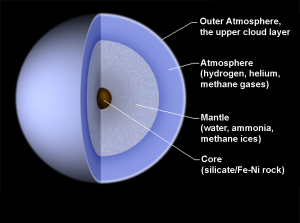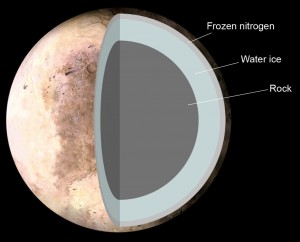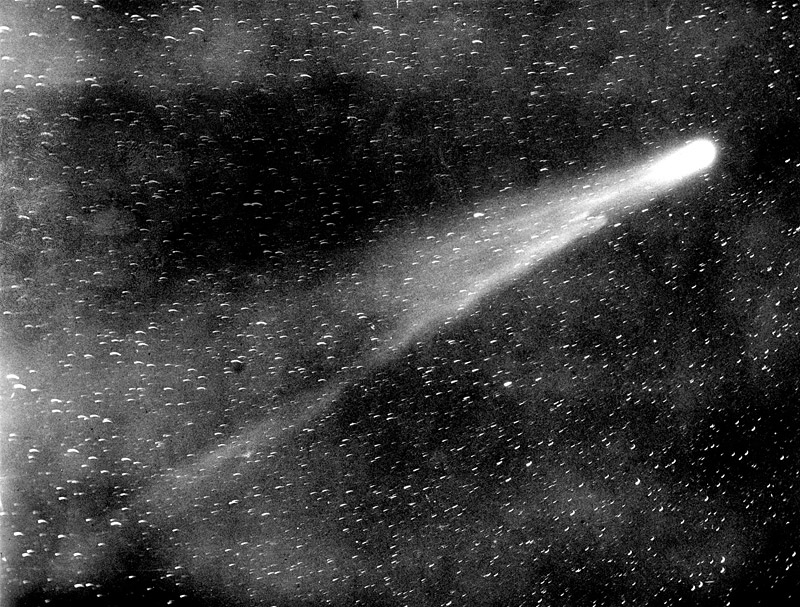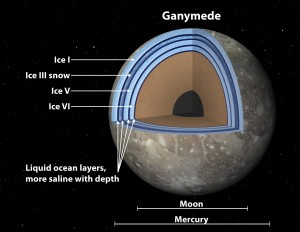When people say Pluto isn’t a planet, they often say it is an icy body and therefore it must be a comet, not a planet. But are icy worlds simply comets? Or can real planets be made of ice? And what is the difference between ice and rock, anyway? Let’s take a look!
Stars with Long Hair
From antiquity, long before we knew what comets are made of, we knew them as stunning phenomena in the sky. The full, original name “star comet” comes from the Greek meaning “star with long hair.” By definition, the essence of a comet is the “long hair”, the tail. If a solar system body doesn’t display this “hair” each time it goes round the sun, it’s not a comet. (That’s why we had to invent the separate name asteroid for bodies that don’t have the “hair”.) We later figured out what comets are made of. They are clumps of ice mixed with dust, flying so near the sun that they are evaporating. The ice can be a mixture of different compositions: frozen water, ammonia, and methane, for example. The tail is the evaporating ice and dust. Since they do evaporate, they must be relatively short-lived bodies. There must be a source for new ones, a reservoir of icy bodies far from the sun, or else they would be all gone by now.

The original meaning of “comet” is “star with long hair”. On the left, Chris Hemsworth is classified as a comet. On the right, he is not classified as a comet. You can discover more comets and non-comets by clicking on the picture.
Some of those bodies far from the sun have been discovered, and they are not classified as comets. They need something to kick them out of their cold orbits so they can move closer to the sun, start evaporating, and grow tails before they can become comets. (And if they are too large, like Pluto, then they still wouldn’t grow tails because their gravity will retain the gas and dust as an atmosphere.) These faraway, icy bodies are classified as Trans Neptunian Objects (TNOs). There are various types of TNOs: Kuiper Belt Objects, Scattered Disc Objects, Extended Disc Objects, and Oort Cloud bodies. Some of these TNOs are called dwarf planets and some are called small solar system bodies, but none of them are called comets because they don’t have the “long hair”.
Some bodies that were once TNOs have been kicked into orbits that come closer to the sun, crossing the orbits of one or more giant planets. but they still don’t come close enough to the sun to form a healthy tail. They form only lesser tails at times. They seemed to be half asteroid, half comet, so they were classified as centaurs. (Centaurs in Greek mythology were half human, half horse.) The centaurs of our solar system are icy bodies but they are not comets.
Some of the moons of giant planets are icy worlds and they are supremely interesting: Europa, Ganymede, Titan, Tritan, and more. Like the TNOs and the centaurs, they may be icy but they are not comets.
To be sure, some icy bodies are comets, but not all of them are comets. Icy bodies can be many things, including centaurs, moons, and even planets if they are big enough. Being icy doesn’t imply that Pluto is a comet.
Planets can be any material or state

Model of the internal structure of Uranus. Note that the icy mantle is believed to be a supercritical fluid, not a solid. Source: Wikimedia
Planets can be made out of any material. They can be rock, metal, gas, ice, or peanut butter. If space aliens have polluted the Milky Way, there might be a planet formed entirely of plastic bottles and K-cups that floated into a clump off the shoulder of Orion. Someday we will recycle that planet. Closer to home, planets like Mercury, Venus, Earth and Mars are made out of rock. Others, like Jupiter and Saturn, are made out of gas. Still other planets are made out of volatiles that have higher melting temperatures, such as methane, ammonia, and water. Planetary scientists call these volatiles ices even when they are in a gas or liquid state, as they are in Neptune and Uranus. So yes, Neptune and Uranus are made out of ices and thus they are classified as ice giants, not gas giants. And yes, they are planets. Bodies made of ices can be planets. Planets can also be in any physical state. Some planets can be in the solid state, like Mercury. Others can have surfaces that are in the liquid state, like Earth’s oceanic surface. Still others can be in the gaseous state, like much of Jupiter. It doesn’t matter which state the matter is in.
The geophysical definition of a planet is simply this: to be a planet, a body must have enough mass to pull itself into a round shape by its own gravity, and it must not have so much mass that it initiates nuclear fusion (for that would render it a star). Composition and physical state do not matter. Icy worlds as large as Pluto easily meet this geophysical definition of a planet.
Ice and rock are not fundamentally different
In fact, the distinction between ice and rock is rather arbitrary. It isn’t a fundamental boundary in physics. When we defined some materials as ices and others as rocks, we drew the line by picking a melting temperature rather close to our body temperature. Why did we do this? We were influenced by the mental conception of ice that we developed here on Earth, where water gets hard and feels cold to our bodies in the winter, then it gets fluid and feels warmer to our bodies in the summer. We started calling the cold version of this water ice. Compounds that stayed solid all year round, on the other hand, we called rock. Thus, the distinction between ice and rock originated from our human experience. There is nothing fundamental about that.
Jeffrey Kargel wrote,
By the geologic definitions of mineral and rock, ice can be both, as can the Solar System’s more volatile condensed solids, such as ammonia dehydrate and nitrogen ice. These minerals melt, respond to stress by fracture and flow, react chemically with one another, weather when exposed at satellite surfaces, and generally do many of the things that Earth’s silicate rocks do, although they do so in unique ways. Some of the basic geologic processes of icy satellites, such as volcanism and tectonism, differ little in their fundamental physics compared to the processes that affect Earth’s silicate rocks… [1]
Also, rock can evaporate like ice and form a tail when a rocky body is close enough to the sun.
If you want to say that rocky worlds can be planets but icy worlds cannot, then to justify it you need to invent some property of ice that makes it fundamentally different from rock. But there is no such property. These materials all exist on a continuum and we drew an arbitrary, human-centered line between them. Planets can exist on both sides of that arbitrary line.
Pluto is not primarily an icy body, anyway

Possible internal structure of Pluto. Source: NASA / Pat Rawlings via Wikimedia
It is perfectly acceptable for a planet to be made out of ice, either fluid ice like Uranus and Neptune or solid ice like the outer layers of Pluto. Nevertheless, this discussion is basically moot. Although Pluto does have an icy exterior, most of its mass is rock. Even if the ice were completely removed from the rock, the amount of remaining rock would be enough mass to qualify Pluto as a planet according to the geophysical definition. Pluto’s ice is just icing on the cake. Adding icing to a cake doesn’t take away the cake. Adding ice to a planet doesn’t take away the planet. It just makes it a bigger, more interesting planet.
Summary
There’s no reason to say icy worlds are comets simply because they are icy. There’s no reason to say icy worlds cannot be planets. Icy worlds are beckoning, and we will probably find that many of them are everything we could want a planet to be. They can be complex with dynamic atmospheres, subsurface oceans, cryovolcanism, even liquid lakes on the surface. I can’t wait for the first close-up views of an icy, Kuiper Belt planet: Pluto, along with its five known moons this July. It will be awesome!
Reference: Jeffrey S. Kargel (1998), “Physical chemistry of ices in the outer solar system.” In B. Schmitt, C. de Bergh, and M. Festou (Eds.), Solar System Ices, Vol. 1. (pp. 3-4). Dordrecht: Springer.

